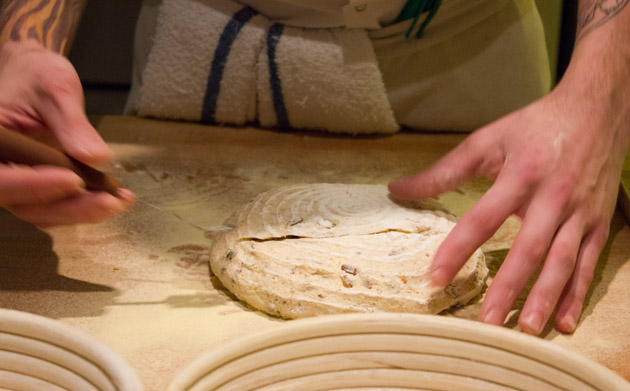10 Things We Learned At The Little Goat Bread Making Class
By Erika Kubick in Food on Nov 19, 2013 4:40PM

This Sunday, we visited Little Goat Bread for a bread making class with their "bread guy" Greg Wade and Girl & the Goat chef Stephanie Izard. At the first class, of what they hope will be many more, we hung out in the kitchen of the private dining area and snacked on an array of tasty breads and a couple of freshly baked cookies while Wade took us through the process of creating several of the loaves at Little Goat Bread. If we learned anything at all, it's that baking is a labor of love and patience. Here are 10 things that Greg Wade taught us about baking bread.
1. Dark crust is good crust. Americans are accustomed to softer, spongy crusts on their bread while Europeans love a hardy crust. Wade chooses the crunchy kind and after one bite, we agree.
2. There are two parts to bread: the crust and the crumb, the loaf's inside texture. Wade bakes all of his loaves until they are nice and crispy on the outside with a moist and fluffy crumb
3. You don't knead to work too hard. Wade mainly uses two techniques, the no knead technique and the autolyse, both of which require less manual labor. All you have to do is form the dough in your hands and allow the gluten to tighten. The dough needs to rest, so never rush the process.
4. It's important to leave a mark. Scoring the dough creates a weak point in the gluten structure, which allows the bread to rise. It also acts as a baker's signature.

5. Wade's starters are named Anne and Buster. A starter is a regenerating fermented mixture of flour and water that develops the characteristic flavor of certain breads. Wade has two starters, the sourdough Anne who was born with Little Goat opened and the newer rye starter, Buster.

6. New York has some serious bagel competition from Montreal. The Canadian-style bagel is shaped by hand, boiled in honey water before baking in a wood-fired oven. Wade demonstrated the Montreal technique with a jalapeno-parmesan bagel and we were sold at the first bite. Sorry New York.
7. Terroir matters with bread. There is a ridiculous number of different kinds of flour, all with different textures and tastes. Where you are actually baking the bread is also crucial because humidity, altitude and temperature affect the process. That's why Chicago summers call for some adjusting.
8. Clay ovens are the best kind. Little Goat has several ovens, including a clay-hearth oven, which is the best for baking bread because it traps steam which develops the crust. Wade gets his ovens so hot the thermometers break, so he has to use his arm. "If you can hold it in the oven for 10 seconds and it doesn't fall off, it's time to break bread" he told us.
9. Little Goat Bakery is pretty much always awake. Production halts from 1:00-3:00 a.m., during which they're usually cleaning. We asked Wade how long he would be working that day; "18 hours," he replied with a smile.
10. It's all about respect. The most important thing we learned is to respect the bread. Bread baking is a science that you have to understand before it becomes your art.